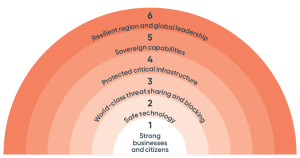Australia’s cybersecurity posture is undertaking an upgrade i.e. a comprehensive overhaul of its cybersecurity framework in response to the rising tide of cyberattacks targeting businesses, government agencies, and critical infrastructure. The government is introducing “unprecedented” cybersecurity legislation to parliament to help protect Australia’s critical infrastructure. These reforms come at a time when the nation is grappling with increasingly sophisticated cyber threats, including ransomware attacks that have compromised sensitive data and disrupted essential services.
These reforms, which are centred on the introduction of the Cyber Security Bill and the development of the 2023-2030 Cyber Security Strategy, are expected to transform the way businesses and government agencies approach cybersecurity. In particular, the new laws will enforce mandatory reporting of ransomware payments and impose stricter regulations on critical infrastructure sectors.
This article explores the key aspects of these reforms and the new legislation introduced by the government to ensure a more secure digital future for the country.
Why Cybersecurity Reforms Are Critical
In recent years, Australia has witnessed a surge in cyberattacks, including high-profile breaches affecting organisations such as Optus, Medibank, and government agencies. These attacks have exposed vulnerabilities in the nation’s digital infrastructure and underscored the need for stronger cybersecurity measures.
A recent report revealed that Australia ranks second in the world for ransomware attacks, highlighting the urgency of these reforms. The Australian Cyber Security Centre (ACSC) has identified ransomware as one of the most significant cybersecurity threats facing the country, with incidents increasing in both frequency and severity over the past few years.
In response, the Australian government has launched the 2023-2030 Cyber Security Strategy, a national plan to enhance cybersecurity resilience across all sectors. The plan acknowledges that Australia faces persistent threats from both cybercriminals and nation-state actors. The strategy emphasises the need for a comprehensive approach, with a focus on improving the security of critical infrastructure, implementing stricter regulations, enhancing cybersecurity awareness among businesses and citizens, and increasing accountability for organisations that fail to protect sensitive data
The Australian Cybersecurity Strategy 2023-2030
The Cyber Security Strategy forms the backbone of Australia’s efforts to combat cyber threats. It emphasises six key pillars, referred to as “shields,” which collectively address various aspects of cybersecurity, such as secure digital infrastructure, public-private collaboration, and increased accountability for cyber incidents. The strategy also introduces a significant shift in how cybersecurity is approached, encouraging both individuals and organisations to adopt a “secure by design” mindset. Check out our more detailed article on Australia’s New Cyber Security Strategy including the six shields.

The six cyber shields
One of the strategy’s critical components is bolstering defences around critical infrastructure, including healthcare, telecommunications, and transport networks. These sectors are seen as high-value targets for cybercriminals and foreign actors, and securing them is essential to maintaining national security.
The strategy also aims to fill the skills gap in the cybersecurity industry by investing in education and training programs. The government is working with universities and vocational institutions to create a pipeline of cybersecurity professionals who can meet the growing demand for expertise in this field.
New Legislation: Cybersecurity Bill and Ransomware Reporting
One of the most significant elements of the new reforms is the introduction of the Cyber Security Bill, which aims to enhance regulatory oversight of cybersecurity practices across various sectors. The bill mandates stricter security protocols for businesses and government entities and introduces new requirements for reporting cyber incidents. Key features of the reforms include:
1. Mandatory Ransomware Reporting
Under the new legislation, businesses and organisations are required to report ransomware attacks and any payments made to cybercriminals. The new reporting requirements are designed to discourage businesses from paying ransoms, as such payments not only fuel further criminal activity but also often fail to result in the secure return of stolen data.
Other updates will address gaps in current legislation to:
- mandate minimum cyber security standards for smart devices,
- introduce a ‘limited use’ obligation for the National Cyber Security Coordinator and the Australian Signals Directorate (ASD), and
- establish a Cyber Incident Review Board.
Moreover, mandatory reporting will allow the government to gain a clearer understanding of the scale of ransomware activity in Australia and help develop more effective strategies for combatting these attacks.
Companies that fail to comply with the reporting requirements could face significant fines and penalties.
2. Improved Cyber Resilience for Critical Infrastructure
The reforms place a strong emphasis on protecting critical infrastructure, such as healthcare, telecommunications, and energy sectors, from cyber threats. These industries are particularly vulnerable to cyberattacks due to the high value of the data they manage and their essential role in maintaining national security. These measures include the requirement for companies to:
- conduct regular risk assessments,
- implement incident response plans, and
- ensure the encryption of sensitive data.
The reforms will advance and implement reforms under the Security of Critical Infrastructure Act 2018 (SOCI Act), which will:
- clarify obligations for systems handling business-critical data,
- enhance government assistance to manage the impacts of all hazards on critical infrastructure,
- simplify information sharing between industry and government,
- introduce powers allowing the government to direct entities to fix serious deficiencies in their risk management programs, and
- align telecommunications security regulation with the SOCI Act.
3. Increased Collaboration Between Government and Private Sector
The reforms encourage greater collaboration between the government and private businesses to share threat intelligence, best practices, and resources for combating cyber threats. This public-private partnership is viewed as essential for creating a unified national defence against cyberattacks.
4. Stricter Penalties for Non-Compliance
Organisations that fail to implement adequate cybersecurity measures or fail to report cyber incidents in a timely manner will face significant penalties under the new legislation. This includes fines and other legal consequences for businesses that do not comply with the new regulations. The aim is to hold businesses accountable for the protection of their customers’ data and to ensure that they take proactive steps to defend against cyber threats.
By enacting stricter laws, the government hopes to create a culture of cybersecurity accountability, where businesses understand the importance of securing their systems and data
Learning from Past Cybersecurity Breaches
Australia’s new cybersecurity reforms have been largely shaped by lessons learned from high-profile data breaches. Two of the most notable incidents include the attacks on telecommunications giant Optus and health insurance provider Medibank, both of which resulted in the exposure of sensitive customer information.
The Optus breach exposed the personal information of over 10 million Australians, including passport numbers, driving licenses, and other sensitive data. The breach was one of the largest in the country’s history and raised serious concerns about the adequacy of corporate cybersecurity practices, leading to widespread criticism of the cybersecurity protocols.
Similarly, the Medibank breach involved the theft of highly sensitive health records, resulting in further scrutiny of how businesses in the healthcare sector manage patient data.
In both cases, the lack of sufficient cybersecurity safeguards and poor incident response strategies were seen as major contributing factors to the scale and impact of the attacks.
These incidents have driven home the importance of proactive measures and incident preparedness.
The government has stressed that organisations must do more to secure their systems against increasingly sophisticated cyberattacks by requiring businesses to:
- implement stronger cybersecurity measures,
- regularly assess their risks and vulnerabilities,
- strengthen third-party vendor management,
- establish dedicated cybersecurity teams, and
- improve their preparedness and response for cyber incidents.
Public-Private Collaboration and Education
The Cyber Security Strategy highlights the importance of sharing threat intelligence and best practices across industries to improve national cybersecurity resilience. A key element of the new reforms is the promotion of collaboration between the government and the private sector. As part of the reforms, the government is encouraging businesses to work closely with agencies such as the ACSC to share information about emerging threats and best practices for mitigating cyber risks
The government has also launched public education campaigns to raise awareness of cybersecurity threats and encourage best practices among individuals and small businesses. These campaigns focus on basic cybersecurity hygiene, such as using strong passwords, enabling multi-factor authentication, and recognising phishing attempts.
The Role of Emerging Technologies
The reforms also take into account the growing role of artificial intelligence (AI) and automation in cybersecurity. With the rapid evolution of cyber threats, AI is seen as a crucial tool in detecting and responding to attacks more quickly and efficiently. Automation can help organisations manage the sheer volume of threats they face, enabling faster identification of vulnerabilities and reducing the time it takes to remediate breaches.
However, the government has cautioned that the implementation of AI-driven solutions must be carefully managed to avoid new risks. For instance, while AI can significantly enhance cybersecurity, it can also be used maliciously by cybercriminals, making it a double-edged sword. Therefore, any deployment of AI technologies must be accompanied by rigorous oversight and testing to ensure they are effective without introducing additional vulnerabilities.
The Future of Cybersecurity in Australia
Australia’s cybersecurity reforms represent a significant step forward in the nation’s efforts to protect its digital infrastructure and safeguard sensitive data. By implementing stricter regulations, fostering collaboration between the public and private sectors, and increasing accountability for cyber incidents, the government is positioning Australia as a leader in global cybersecurity.
However, the success of these reforms will depend on the willingness of businesses and government agencies to adopt a proactive approach to cybersecurity. As cyber threats continue to evolve, it is essential that organisations remain vigilant and continuously improve their security practices.
Australia’s new cybersecurity reforms provide a comprehensive framework for addressing the growing cyber threat landscape. With the introduction of mandatory ransomware reporting, stricter penalties for non-compliance, and a strong focus on collaboration and education, the nation is well on its way to building a more secure digital future
How can we help enhance cyber security?
We are here to help strengthen cyber resilience. Our cyber risk management capabilities include designing and developing a cyber risk management framework and a wide range of response plans to enhance your cyber resilience capabilities. Our cyber risk management services include:
- Vulnerability scanning
- Cyber Security Gap Analysis against Essential Eight, ISO 27001 or APRA’s CPS234
- Regulation compliance advice
- Cyber Risk Governance Framework Reviews
- Cyber Risk Governance Framework Development
- Third-Party Vendor Review and Cyber Risk Analysis
- Cyber Risk Awareness Training and Internal Campaigns
- Post-Cyber Incident Review
- Email Phishing Campaigns
- Cyber Incident Response
- Crisis Team Familiarisation Training
- AI Risk Governance
Be more resilient to a wide range of cyber risks and get relevant insight into how to protect your systems by contacting us to discuss how we can help strengthen your cyber resilience framework.
